Physical Address
304 North Cardinal St.
Dorchester Center, MA 02124
The concept of the ‘lid wiper’ and a proposed condition brought about by disturbance to this structure, referred to as ‘lid wiper epitheliopathy’ (LWE), were first described by Korb et al. in 2002. The terms ‘lid wiper’ and ‘LWE’ are becoming increasingly common when referring to the aetiology, diagnosis and management of dry eye in contact lens wearers and non–lens wearers.
The lid wiper is proposed to be that portion of the marginal conjunctiva of the upper eyelid that acts as a wiping mechanism for spreading the tear film over the ocular surface or over the surface of a contact lens. There is also a lid wiper in the lower lid, but its role in spreading tears is less certain, as discussed later. LWE is the term used to describe disruption to the surface epithelium of the lid wiper, typically observed using vital dyes.
Keen interest in the concept of the lid wiper and LWE possibly stems, at least in part, from the apparent difficulty encountered by clinicians and scientists in diagnosing, reconciling signs and symptoms and treating dry eye syndrome. Moreover, little progress has been made in understanding the root cause of contact lens discomfort, which, in turn, is a major reason for discontinuation from contact lens wear, causing great inconvenience to lens wearers and missed economic opportunity for contact lens practitioners and the contact lens industry.
In broad terms, the lid margin is divided into three distinct anatomical sub-zones: (1) the skin epidermis extending over the meibomian gland orifices; (2) the mucocutaneous junction, which is the transition region between the skin epidermis and the conjunctival tissue – the surface that represents the line of Marx; and (3) the lid wiper ( Fig. 5.1 ).
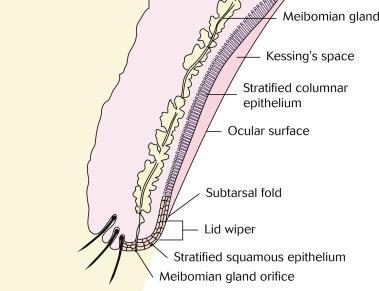
Ehlers appears to have first connected the action of the lid to that of the windscreen wiper of a car. He did not specifically provide terminology for the region, but when referring to the part of the lid that rubs against the bulbus during blinking, he stated: ‘This soft (unkeratinised) bead gliding over the cornea must be assumed to be a perfect “wind screen wiper”’. Fatt later referred to the ‘wiper blade’ action of the upper lid in spreading tears over the ocular surface.
In their initial paper on this topic, Korb et al. carefully defined the lid wiper region and precisely mapped out its location in relation to adjacent commonly recognised anatomical landmarks. Accordingly, the location of the lid wiper is clear and unambiguous in all subsequent papers by Korb and other researchers who have coined this specific term. However, some have adopted different terminology. For example, Munger and Halata referred to the ‘angle’. McGowan et al. used the terms ‘marginal zone’ and ‘marginal angle’. Navascues-Cornago et al. were clearly examining the lid wiper but used the terms ‘lid margin’ and ‘marginal conjunctiva’, both of which were apparently considered to be synonymous with ‘lid wiper’. Golebiowski et al. also used the term ‘lid margin’ to indicate the lid wiper region for staining purposes but measured ‘lid margin sensitivity’ at the ‘occlusal surface’.
With respect to the term ‘lid wiper epitheliopathy’, it is perhaps worth considering the appropriateness of the suffix ‘-pathy’, which indicates a ‘morbid condition or disease; generally used to designate a non-inflammatory condition’. Two questions arise: (1) To what extent is LWE truly a ‘disease’? (2) Is there evidence that it has an inflammatory component? If the answer to the latter question is in the affirmative, then the term ‘lid wiper epitheliitis’ may be more appropriate.
The anatomy and histology of the eyelid margin have been described in a small number of papers throughout the 20th century, although the structure of the lid wiper as a defined anatomical region has only been investigated fairly recently.
According to Korb et al. the anatomical area of the lid wiper region is the portion of palpebral marginal conjunctiva in the upper and lower lids that is in contact with the globe. In the upper lid, it extends from the crest of the sharp posterior (inner) lid border (i.e. the mucocutaneous junction, or line of Marx) to the subtarsal fold superiorly and from the medial upper punctum to the lateral canthus horizontally. This configuration is similar in the lower lid.
The idea that the lid wiper is essentially the only part of the upper lid wiping tears across the ocular or contact lens surface assumes that the tarsal conjunctiva does not contact the opposing ocular or contact lens surface. Part of this reasoning is that the lid wiper is the only part of the eyelid to exhibit non-keratinised stratified squamous epithelium, a characteristic feature of other body tissues that experience frequent rubbing.
Ehlers made the further observation that blinking would be impeded if the tarsal region of the lid was sucked closely against the eye. Kessing investigated the notion that there is a gap between the tarsal conjunctiva and ocular surface, which extends vertically from the lid wiper to a region approaching the upper fornix; this has become popularly known as ‘Kessing’s space’.
The word ‘space’ in the term ‘Kessing’s space’ implies an empty area; however, this may not be the case. Using electron microscopy, Doughty observed a very thick, fixed gel layer across the palpebral conjunctiva in rabbits. He suggested that this mucus layer is important in providing a robust lubrication system to facilitate regular blink activity. Doughty went on to propose that the mucus-based material likely fills Kessing’s space, although this has yet to be confirmed in humans.
Knop et al. measured the upper lid wiper in human cadaver eyes and noted that it is of variable width, ranging from 0.3 to 0.5 mm, and forms a slope. This was confirmed by Shaw et al., who rested the lid margin of a series of subjects against pressure-sensitive paper and determined the lid wiper to be to 0.60 ± 0.16 mm wide (range 0.33–0.84 mm).
There are two regions of interest here, namely, the mucocutaneous junction and the newly proposed lid wiper. These two adjacent structures will be considered separately.
The first detailed account of the mucocutaneous junctions was provided in 1924 by Marx, hence the eponymous name of this anatomical feature as the ‘line of Marx’.
Knop et al. and Doughty characterised the mucocutaneous junction as being composed, at least in part, of squamous cells; however, the description provided by Jalbert et al. is more consistent with non-squamous cells. This discrepancy may relate to a number of factors, including the use of different staining techniques, assessment of the line of Marx in the upper lid versus the lower lid and the observation of non–contact lens wearers only versus a mixed cohort of lens wearers and non–lens wearers.
The width of the line of Marx was measured by Knop et al. to be 0.2 to 0.3 mm wide. Doughty determined the line of Marx to be up to 0.3 mm wide but noted that when stained with lissamine green, it could be close to 0.5 mm wide in some subjects. These values are somewhat greater than the estimates of Donald et al. (0.10 ± 0.09 mm) and Shaw et al. (0.09 ± 0.02 mm) ( Fig. 5.2 ). Differences in accounts of the width of mucocutaneous junction may be attributed to differences in in vitro versus in vivo measurement.
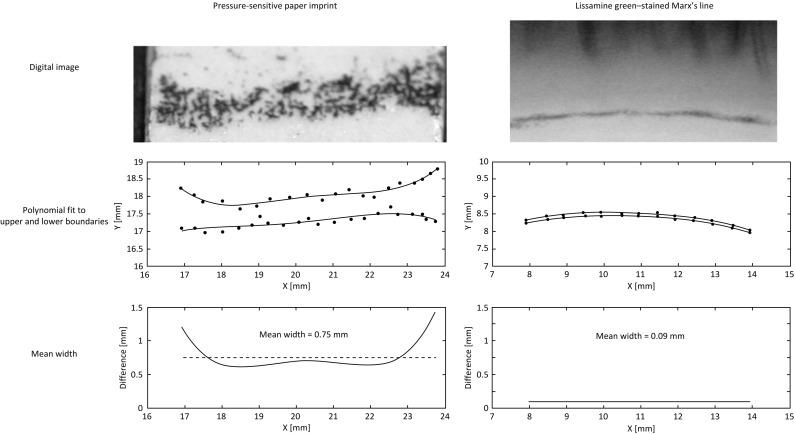
Knop et al. described the lid wiper as an epithelial elevation that typically has an initial thickness of about 100 μm. They described the lid wiper as consisting of stratified epithelium with a conjunctival structure of cuboidal cells, some parakeratinised cells and goblet cells, with a superficial flattened polygonal mesh of small vessels. The goblet cells observed in the lid wiper occur either singly or in clusters. Specifically, they are located in both superficial and deeper layers of the epithelium and along epithelial crypts that are connected to the surface ( Fig. 5.3 ). These goblet cells secrete soluble mucins onto the lid wiper surface. Along with the tear film, the mucins form a hydrated gel between the lid wiper and the ocular surface to provide lubrication so that the lid wiper and ocular surface are separated by a fluid film consisting of mucin and aqueous components.
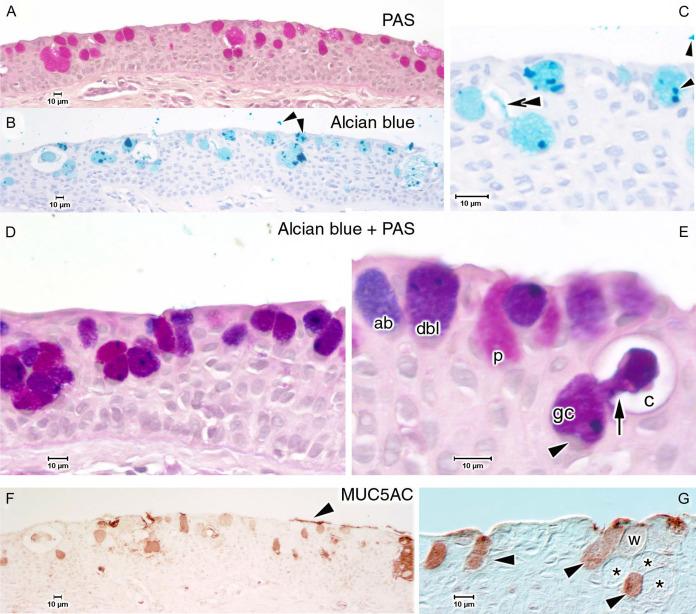
Munger and Halata conducted a histological investigation of the neural tissue of a region they referred to as the ‘angle between occlusal and conjunctival surfaces’, which approximates to the lid wiper region. They observed a few special nerve endings consisting of scattered simple corpuscles and scant Meissner corpuscles. Simple corpuscles are often associated with presumptive intra-epithelial free nerve endings.
Further aspects of lid wiper neuroanatomy can be inferred from measures of tactile sensitivity of this tissue. Although a number of authors claimed to have measured the sensitivity of the lid margin, only two appear to have genuinely measured the sensitivity of the lid wiper. McGowan et al. used a Cochet-Bonnet aesthesiometer to measure touch thresholds of three regions of the eyelid: the middle of the tarsus, the lid wiper (referred to as the ‘marginal angle’) and the non–lid wiper region of the lid margin (referred to as the ‘occlusal surface’). The lid wiper was the most sensitive of the three regions.
Navascues-Cornago et al. also used the Cochet-Bonnet instrument to measure the touch sensitivity of the cornea, bulbar conjunctiva, lid wiper and tarsal conjunctiva. They found that the cornea was the most sensitive of these tissues but that the lid wiper was more sensitive than other regions of the conjunctiva. The implication from these works is that the lid margin is more richly innervated compared with the surrounding conjunctival and lid tissues but is less richly innervated compared with the cornea.
With the upper eyelid everted, the lid wiper can be seen in white light as a long, thin pale band of tissue beneath the eye lashes extending laterally from inner to outer canthus ( Fig. 5.4 ). Disturbance to the superficial epithelium of the lid wiper is not visible in white light but can be observed with the aid of vital dyes. A key question to be addressed is the extent to which lid wiper staining correlates with symptoms of discomfort.
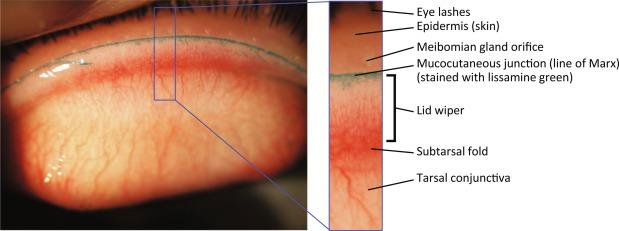
In their original paper, Korb et al. described the application of fluorescein followed by rose bengal stain but subsequently advocated use of a mixture of 2% fluorescein and 1% lissamine green stains.
Different research groups subsequently used a variety of staining approaches when examining the lid wiper, including the use of fluorescein only, lissamine green only, fluorescein and rose bengal, fluorescein and lissamine green and a triple combination of fluorescein, lissamine green and rose bengal stains ( Fig. 5.5 ). In more recent times, the trend has been to use lissamine green only.
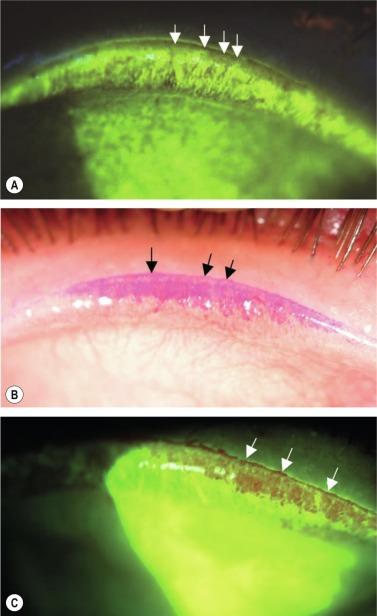
Varikooty et al. described an optimised technique for staining the lid wiper as follows: Moisten two strips with 1 mg lissamine green; hold the strips together; then, apply to the eye with 50 μL of saline. Repeat this procedure 1 minute later. Evert the eyelid 3 minutes after the second instillation to visualise the lid wiper. The beam of the slit lamp is set to maximum width and 10 mm height, and the potentiometer is set to provide maximum illumination.
In assessing the lid wiper after contact lens wear, Korb et al. simply considered the lateral extent of the band of staining as the basis for grading LWE. However, complex patterns of staining have been reported.
Varikooty et al. investigated staining patterns observed in those wearing silicone hydrogel contact lenses. At times, no staining was observed. Staining that was present was categorised into six patterns: vertical streaks, short horizontal band, broad horizontal band, speckled appearance, comb-shaped appearance and atypical appearance ( Fig. 5.6 ). Little difference was observed between the patterns of stains reveled by fluorescein and lissamine green.
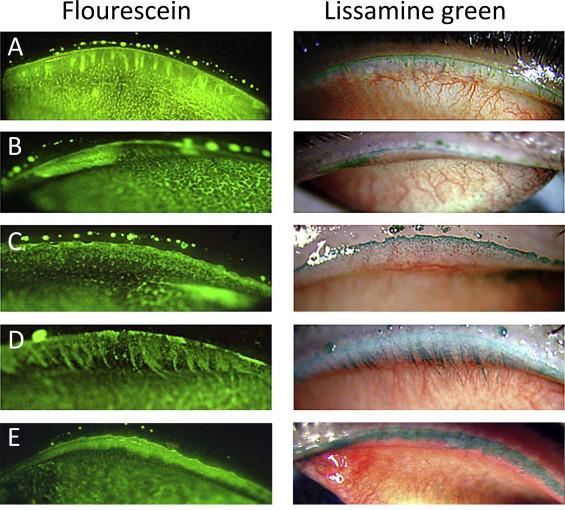
Korb et al. advocated a grading technique that accounted for staining observed with both fluorescein and lissamine green. Specifically, fluorescein staining of the lid wiper was graded from 0 to 3 for each of two characteristics: the linear area of involvement ( Table 5.1 ) and the severity of the staining ( Table 5.2 ). The total grade for fluorescein staining of the lid wiper is the average of the grades for the linear area and severity of staining. This procedure was repeated for lissamine green. The higher of the final fluorescein or lissamine green staining grades is used as the LWE severity grade, whereby 0.5 to 1.0 = grade 1 LWE (mild); 1.25 to 2.0 = grade 2 LWE (moderate); and 2.25 to 3.0 = grade 3 LWE (severe).
| Linear Area of Staining | Grade |
|---|---|
| < 2 mm | 0 |
| 2–4 mm | 1 |
| 5–9 mm | 2 |
| ≥ 10 mm | 3 |
| Severity of Staining | Grade |
|---|---|
| Absent | 0 |
| Mild | 1 |
| Moderate | 2 |
| Severe | 3 |
Korb et al. made the point that it is very important to differentiate any staining across the proposed lid wiper zone/region from that staining seen at the line of Marx, which invariably stains bright as a clearly delineated thin line at the distal border of the lid wiper with all three staining agents. Others have noted that grade 0 LWE shows staining only of the line of Marx, but grade 1 LWE, for example, shows a slight staining of the lid wiper lesion in addition to the staining of the line of Marx. In attempting to objectively assess overall staining across the marginal zone, the line of Marx may also be included in the measurements and still be referred to as the ‘lid wiper’.
Guillon and Maissa judged the extent of lissamine green staining of the lid wiper in terms of staining type (0 = none; 1 = broken line; 2 = thin line; 3 = thick line/patch) and staining severity (0 = none; 1 = slight; 2 = mild; 3 = moderate; 4 = severe).
Kunnen at al. compared a semi-objective method of grading LWE with subjective assessment. They found that human observers tended to overestimate the height and underestimate the width of LWE staining.
Guillon and Maissa evaluated the incidence and type of lid margin staining in 75 consecutive patients (30 males, 45 females) aged 18 to 62 years (mean age 33.1 ± 11.5 years) presenting to an eye clinic; the population included non–contact lens wearers and contact lens wearers. The upper and lower lid margin staining was evaluated with lissamine green and was judged by using their grading system as described previously.
In the majority of cases, staining was rated as mild or moderate for both the upper (mild = 39.6%; moderate = 37.6%) and lower (mild = 38.9%; moderate = 38.3%) eyelid margins. The staining observed was most commonly of the ‘thin line’ type (upper lid = 65.3%; lower lid = 63.3%). Clinically significant ‘thick line/patch’ staining was observed in about 1 in 4 eyelids (upper = 23.3%; lower = 25.3%). The results were highly correlated between the upper and lower lid margins (r = 0.895–0.918; p < 0.001) and between the right and left eyes (r = 0.820–0.987; p < 0.001). The authors concluded that LWE is present in 25% of a population presenting to an eye clinic.
The prevalence of upper and lower LWE was examined by using combined fluorescein and lissamine green staining in 405 eyes of 208 soft contact lens wearers, 135 eyes of 71 rigid contact lens wearers and 443 eyes of 229 non–lens wearers by Shiraishi et al. Tear break-up time (TBUT) and corneal and conjunctival staining were also assessed. The prevalence/mean grade of lower LWE (39.5% (0.79)) was significantly higher than that of upper LWE (12.5% (0.21)) in non–lens wearers (p < 0.001). The prevalence/mean grade of upper LWE was significantly higher in rigid contact lens wearers (84.4% (1.3)) compared with soft lens wearers (58.1% (2.1)) (p < 0.001). There was no difference in prevalence/mean grade of lower LWE between rigid and soft lens wearers.
The prevalence of both upper LWE and lower LWE were significantly correlated with age and corneal and conjunctival staining, but not sex and TBUT, in non–lens wearers. The prevalence of both upper LWE and lower LWE was significantly higher in younger subjects (p < 0.001). Upper LWE and lower LWE were detected in a higher percentage of contact lens wearers than in non–lens wearers (p < 0.001).
Alghamdi et al. examined the lid wiper in 60 current contact lens wearers, 20 previous contact lens wearers and 20 non–lens wearers. They found no difference in the severity of LWE amongst the three groups.
A number of studies have explored the relationship between LWE and symptoms of dryness or discomfort in contact lens wearers. This question has generally been approached by assessing the incidence and/or severity of LWE among symptomatic versus asymptomatic contact lens wearers. The findings of research so far addressing this question are equivocal.
Korb et al. reported a mean score for symptoms of 0.3 points for a group of asymptomatic lens wearers versus 7.2 points for a symptomatic group, out of a possible 12 points. Twenty-four (80%) of the 30 symptomatic subjects displayed LWE compared with 10 (13%) of 75 asymptomatic subjects (p = 0.0001). The authors suggested that LWE is associated with symptoms of dry eye in contact lens wearers.
Berry et al. found that upper LWE scores were significantly greater in symptomatic versus asymptomatic contact lens wearers (p < 0.035), although there was no such association demonstrated for lower LWE.
Pult et al. reported that severity scores for LWE were significantly greater in symptomatic versus asymptomatic patients (U-test; p < 0.03). They noted that the predictive values derived from the receiver operating characteristic (ROC) curve indicated that LWE served better as a test for excluding dry eye symptoms.
Yan et al. found an association between LWE and dry eye irrespective of whether or not contact lenses are worn.
Pult et al. reported that LWE was significantly increased when wearing contact lenses; however, the LWE score was found to be of little value in predicting contact lens–induced dry eye.
Varsani and Wong reported that LWE staining was greater for symptomatic lens wearers versus asymptomatic lens wearers for both lids and the lower lid.
Yeniad et al. assessed LWE by using fluorescein, rose bengal and lissamine green in 42 symptomatic contact lens wearers and 27 asymptomatic contact lens wearers. Dry eye was assessed in all participants by using a subjective questionnaire and three objective tests – Schirmer I test, fluorescein break-up time and fluorescein corneal staining. The prevalence of staining with the three dyes in the symptomatic and asymptomatic contact lens wearers were as follows: fluorescein 67% and 32%, respectively (p = 0.001); rose bengal 59% and 41% (no statistics provided); and lissamine green 61% and 39% (no statistics provided). The authors were unable to demonstrate a correlation between LWE and fluorescein break-up time or Schirmer I test results. The authors concluded that LWE should be investigated in symptomatic contact lens wearers who yield normal results with tests for dry eye.
Best et al. fitted monthly replacement silicone hydrogel contact lenses to 60 subjects who had never worn contact lenses previously and monitored them for 6 months. The authors reported that LWE was unable to discriminate between those who dropped out of lens wear trial versus those who completed the 6 months of the trial (ROC area under the curve = 0.511).
Read et al. assessed symptoms and lissamine green staining of the upper and lower lid wipers in 10 symptomatic lens wearers, 10 asymptomatic lens wearers and 10 non–lens wearers, at afternoon visits. They concluded that inspection of the lid wiper region with lissamine green staining does not appear to differentiate between symptomatic and asymptomatic contact lens wearers.
Navascues-Cornago et al. reported that among lens wearers, a significant increase in lower lid wiper staining was found after 12 hours of lens wear compared with baselines measures (p = 0.04). However, lid margin staining was not significantly different between symptomatic and asymptomatic lens wearers (Mann-Whitney U test; all p > 0.05).
In a large multi-centre study, Schulze et al. assessed subjective comfort in 246 participants wearing their habitual soft contact lenses. After lens removal, the lid wiper was graded by using fluorescein and lissamine green. The authors were unable to demonstrate a relationship between comfort scores and the severity of LWE.
Stahl and Jalbert conducted a randomised, cross-over study on 20 subjects who wore comfilcon A and lotrafilcon A lenses for 10 days separated by a 7-day washout period. Tear and contact lens osmolarity; ocular symptoms, including comfort, tear stability and production; and LWE were measured. The authors were unable to demonstrate an association between comfort LWE.
Efron et al. reported the results of a meta-analysis of data extracted from six studies examining the relationship between LWE and contact lens comfort. A total of 587 subjects were enrolled in these studies, comprising 180 males and 407 females (age 28.5 ± 7.8 years (range 18–62 years)). LWE was assessed using fluorescein and lissamine green staining, and comfort was assessed using a validated patient reported outcomes instrument, known as the ‘contact lens user experience’ (CLUE) metric. The authors were unable to demonstrate a significant relationship between grade of LWE and CLUE score (F = 1.21; p = 0.298) ( Fig. 5.7 ).

Preliminary studies employing immunocytochemistry, impression cytology, functional slit lamp biomicroscopy and corneal confocal microscopy have shed some light on the likely tissue pathology underlying LWE, and aesthesiometry of the lid wiper margin has highlighted possible functional deficits associated with this condition.
Jalbert et al. performed immunocytochemistry for the keratinization-related proteins filaggrin, transglutaminase1 and cytokeratin 1/10 on impression cytology samples collected from a broad region of the upper lid margin. The authors demonstrated expression of all of these proteins from lid margin epithelium, suggesting the possibility of pathological processes occurring in superficial epithelial cells of the lid wiper.
Evidence from studies using invasive techniques (impression cytology) and non-invasive approaches (laser scanning confocal microscopy and functional slit lamp biomicroscopy) shed some light on contact lens–induced structural changes in the lid wiper.
Become a Clinical Tree membership for Full access and enjoy Unlimited articles
If you are a member. Log in here